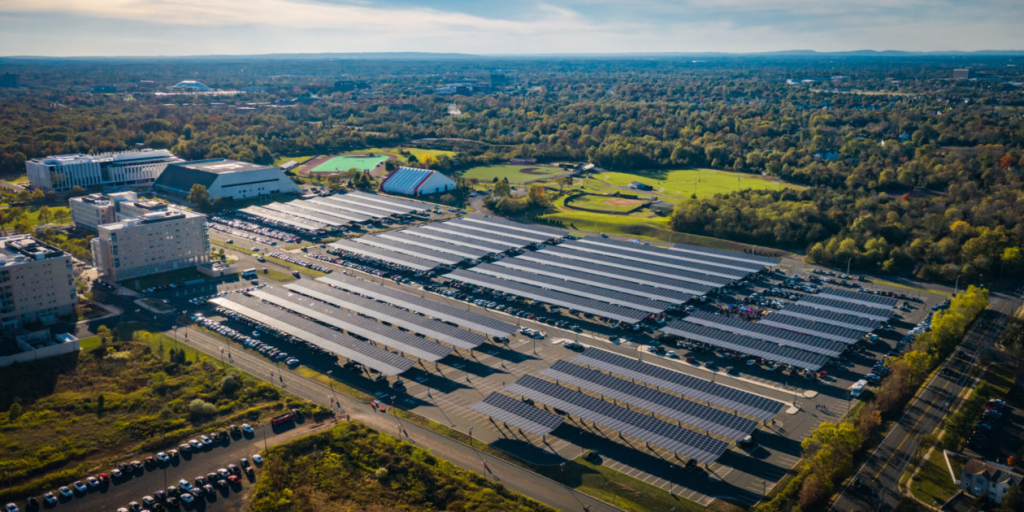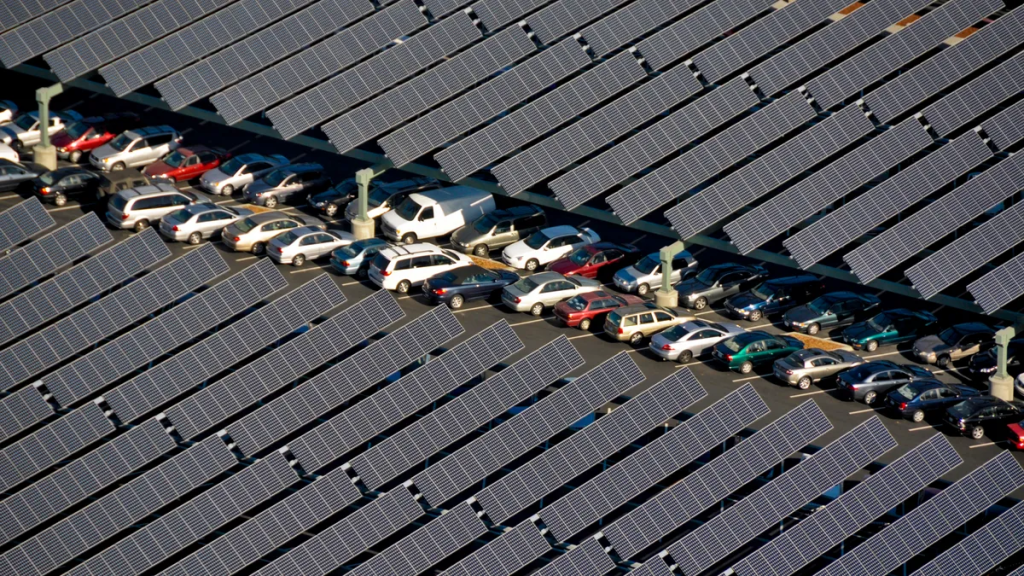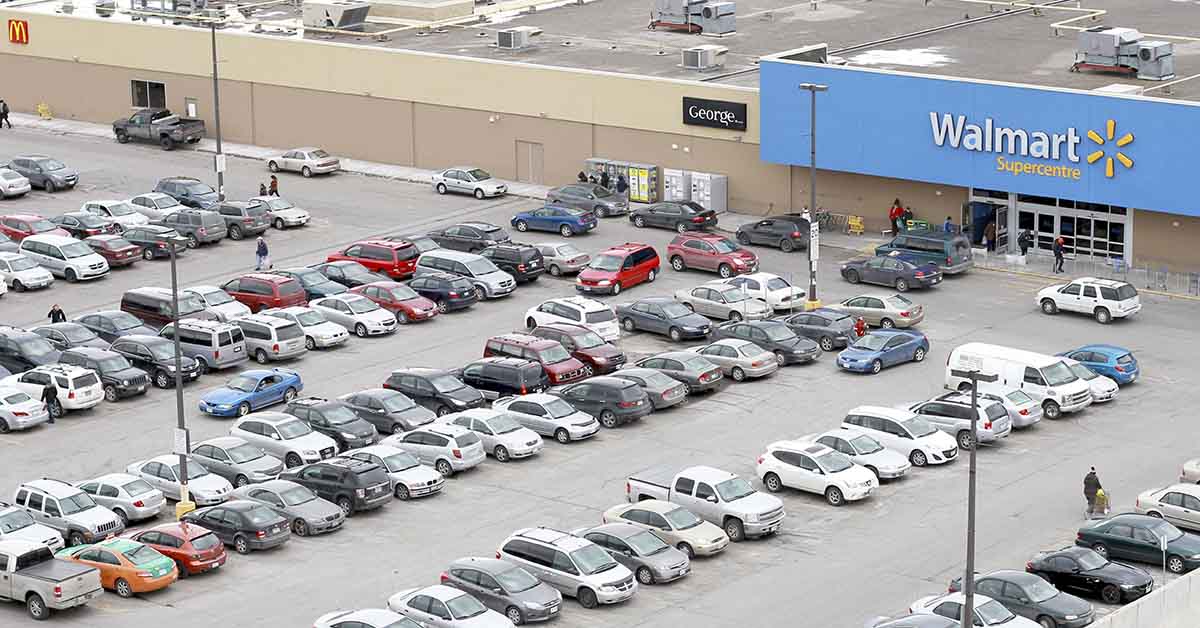The United States is standing at the cusp of a significant change, perhaps the most consequential since the New Deal. Shifting to cleaner sources of power demands a massive increase in solar power. Not just limited to home rooftop setups but also solar installations located near urban areas.
However, a critical question arises, one that Mother Jones pointed out: where can we mount all these solar panels? One potential solution is over-parking lots, which tend to heat up during the summer, contributing to dangerous “heat island” effects.
By shading large retail parking lots with solar canopies, like those of Walmart Supercenters, enormous amounts of electricity can be generated. Also, stores can attract customers by offering free electric vehicle charging and cooler parking spaces. After all, a comfortable customer is a satisfied customer.
Facts that could alter your perspective on solar panel parking lots
There are a total of 3,572 Walmart Supercenters in the United States. On a very hot day with a temperature of 100 degrees Fahrenheit, the air temperature in the Supercenter parking lot can reach as high as 120°F. However, when a 100-space parking lot is partially shaded, there can be a notable drop of 10°F in the air temperature.
The minimum spaces in surface parking lots across the United States amount to 300 million, occupying a total land area of around 1400 square miles. If each parking space had solar canopies, the added generation capacity would be 1.5 terawatts. Comparatively, the overall generation capacity in the United States as of January 2023 stands at 1.2 terawatts.

It’s time to change
There is growing opposition to industrial-sized solar farms, with at least 75 such projects vetoed across the US in 2022 compared to 19 in 2021. While between January 2021 and July 2022, planning permission was rejected for 23 solar farms across England, Wales, and Scotland. Compared to just four between 2017 and 2020.
The French Senate has proposed a solution by passing a bill requiring new and existing parking lots with more than 80 spaces to have canopies of solar panels covering at least 50% of them. Parking lots with over 400 spaces are required to comply by 2026. And those with 80 to 400 spaces by 2028.
Solar canopies installed in parking lots make sense aesthetically and logistically. Especially given the need to transmit electricity generated from rural solar farms to energy-hungry urban areas. And the potential environmental impact of large-scale rural solar farms. Parking lots, however, present potential as multifunctional spaces to house solar panels. Such as on rooftops, vacant lands, industrial sites, and airports.
Read: In France, All Large Parking Lots Now Have to be Covered by Solar Panels
Where does one even begin?
Parking lots are especially attractive, as they are often large and abundant. Installing solar panels over the parking lots of Walmart stores could generate electricity equivalent to that of around a dozen coal-fired power plants. Additionally, the energy generated can be used to provide shade and shelter for cars. And if the vehicles parked beneath the canopies are electric, the energy generated could be delivered directly to the cars. Thereby possibly balancing the grid. The installation of solar canopies in parking lots, however, requires bidirectional charging equipment, smart automation, and coordination with the power grid.
Currently, almost 40% of the US electricity supply is sourced from carbon-free sources, including nuclear, hydropower, wind and solar power. However, electricity generation is still a significant contributor to greenhouse gas emissions. Accounting for about 25% of US climate-warming pollution, second only to vehicles.
Combating roadblocks
To combat this, there are two major challenges: firstly, increasing the share of carbon-free electricity from 40% to 100% as quickly as possible and at the same time, doubling the electricity supply to accommodate the growth of electric vehicles, heat pumps, and industrial electrification. This will require building as much new clean generation by 2035 as the total electricity produced by all sources today, then building that same amount again by 2050.
To achieve this, we will need utility-scale solar projects that cover an area the size of Massachusetts, Rhode Island, and Connecticut combined, as well as wind farms that span an area equal to that of Illinois, Indiana, Ohio, Kentucky, and Tennessee. However, due to spacing requirements, turbines will only physically occupy 1% of the required area.
The challenge ahead is to double the electricity generation of the grid using only new, clean resources within just three decades. In the short term, the focus is on rapidly expanding wind and solar power. By the end of 2030, we must double our fastest pace of adding renewables and then accelerate to 3.5 times that rate by 2035. New technologies such as advanced geothermal, nuclear, carbon capture and storage, clean hydrogen, and large-scale energy storage are also being developed and brought to market.
Ever been to Michigan State University? They have solar panel parking lots

Commuters who park their vehicles at Michigan State University’s campus can enjoy the convenience of covered parking spots. This is made possible by the installation of solar panels above each parking lot, shielding them from harsh elements such as sunlight, snow, and rain. These panels are mounted on sturdy steel structures that are high enough to accommodate RVs. Allowing tailgaters to park underneath them. Apart from enhancing the parking experience, the university is also benefiting from the use of sustainable and affordable solar energy generated by solar panels.
Is this all just a pipe dream or can alternative energy really save us?
At the current rate of building wind and solar power, it’s necessary to build new power lines at double the speed of the past decade. The demand for new electric vehicles and heat pumps means that we require a larger grid, and by 2035, we need to build up to 75,000 miles of new high-voltage lines. To put that in perspective, it’s the same as running the distance from Los Angeles to New York City and back 15 times or circling the Earth three times.
It’s achievable, though. In the 1970s through the 1990s, as electricity consumption increased, we constructed new transmission capacity nearly at the pace needed today. If we can do it again, we unlock 1,280,000 megawatts of green energy projects that are waiting for grid connections. Even if only half of those projects are completed, we would have all the new capacity needed by 2030.
The alternative, if we don’t expand the transmission grid quickly enough, is disastrous. We risk losing up to 80% of the emissions reductions that the three laws could provide, as increasing demand for electrification is met with natural gas and coal-fired power plants instead of renewables.
There is more to be done to make this all happen
Of course, a new grid is just one aspect of the bigger picture. We also need to establish new factories to manufacture electric vehicles, batteries, wind turbines, solar panels, and their parts. Additionally, we need to develop new industrial clusters to harness clean hydrogen and capture carbon dioxide emissions. As well as create pipelines to transport these gases safely.
We need to create charging networks for personal vehicles and heavy-duty electric trucks and buses, and much more. In short, we need to build, build, build to accomplish the transformation to a carbon-free energy system.
Keep Reading: Switzerland Set to Roll Out Solar Panels Between Railway Tracks–A World First
Sources
- “What if Walmart Turned Its Parking Lots Into Solar Farms?” Mother Jones. Michael Mechanic. May-June 2023.
- “Why Not Cover Ugly Parking Lots With Solar Panels?.” Wired UK. William Ralstone. January 23, 2023

